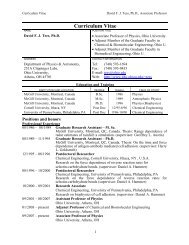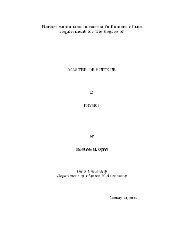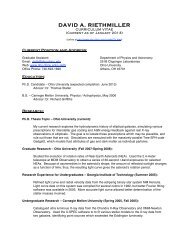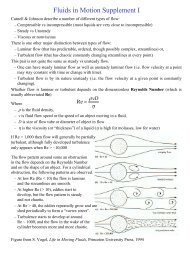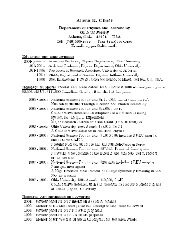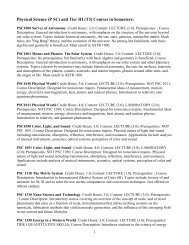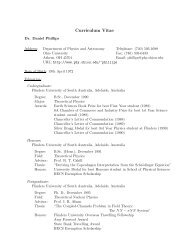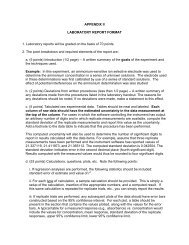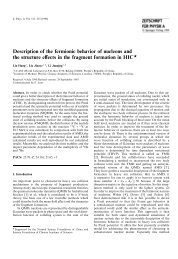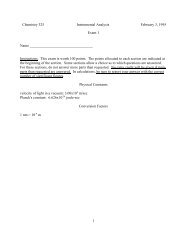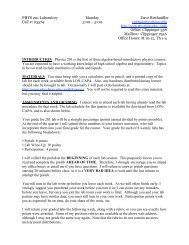Manipulation of Atoms and Molecules with the Low-Temperature ...
Manipulation of Atoms and Molecules with the Low-Temperature ...
Manipulation of Atoms and Molecules with the Low-Temperature ...
You also want an ePaper? Increase the reach of your titles
YUMPU automatically turns print PDFs into web optimized ePapers that Google loves.
4410 Jpn. J. Appl. Phys. Vol. 40 (2001) Pt. 1, No. 6B G. MEYER et al.<br />
Fig. 2. (a) STM image <strong>of</strong> <strong>the</strong> Br<strong>and</strong>enburg Gate, as a very recent example<br />
<strong>of</strong> lateral manipulation. CO molecules deposited on Cu(211) were used.<br />
The substrate temperature was 15 K.<br />
After successfully manipulating small molecules such as<br />
CO <strong>and</strong> C 2 H 4 , we experimented <strong>with</strong> <strong>the</strong> manipulation <strong>of</strong><br />
atoms such as Pb <strong>and</strong> Cu. 7) Applying higher forces, we<br />
demonstrated on Cu(211) that it is also possible to release na-<br />
tive substrate atoms from sixfold coordinated kink sites (Figs.<br />
4(a)–4(c)) <strong>and</strong> even from sevenfold co-ordinated regular stepedge<br />
sites (Figs. 4(d)–4(g)). 8) This important result opens <strong>the</strong><br />
way for <strong>the</strong> structuring <strong>of</strong> <strong>the</strong> surface itself, <strong>with</strong> <strong>the</strong> additional<br />
prospect that deeper lying substrate layers may also be<br />
included in <strong>the</strong> buildup <strong>of</strong> artificial prototype structures. We<br />
have also shown that vacancies at <strong>the</strong> step edges <strong>of</strong> regularly<br />
stepped surfaces such as Cu(211) can be filled by manipulating<br />
single atoms into <strong>the</strong>m; interestingly, a larger force is<br />
required for this purpose than for manipulation along defectfree<br />
step edges. 8)<br />
The structure presented in Fig. 5 shows <strong>the</strong> formation <strong>of</strong> a<br />
quantum corral by <strong>the</strong> lateral manipulation <strong>of</strong> Ag atoms on<br />
a Ag(111) surface, similar to those first created in Eigler’s<br />
group. The atoms have been positioned in a circle <strong>with</strong> a<br />
diameter <strong>of</strong> 22 nm. The electrons in <strong>the</strong> surface state are<br />
scattered by <strong>the</strong> Ag atoms resulting in a circular interference<br />
pattern. The observed st<strong>and</strong>ing wave pattern becomes highly<br />
sensitive to <strong>the</strong> phase relaxation length <strong>of</strong> <strong>the</strong> electrons if <strong>the</strong><br />
diameter <strong>of</strong> <strong>the</strong> corral is <strong>of</strong> comparable size. 9) In this context<br />
<strong>the</strong>se corrals may be thought <strong>of</strong> as nanoscale quantum laboratories.<br />
Manoharan et al. have shown that in an elliptical<br />
corral, a magnetic atom placed in one focus is seen as a mirage<br />
at <strong>the</strong> o<strong>the</strong>r focus via its magnetic Kondo signature. 10)<br />
Fig. 3. Sequence <strong>of</strong> STM micrographs showing <strong>the</strong> gradual build-up <strong>of</strong> <strong>the</strong> symbol “2000” <strong>with</strong> CO molecules on a Cu(211) substrate.<br />
Notice that an area completely free from CO molecules had to be prepared at <strong>the</strong> beginning.<br />
Fig. 4. <strong>Manipulation</strong> <strong>of</strong> native Cu atoms from six fold coordinated kink sites at defect steps ((a)-(c)) <strong>and</strong> from seven-fold coordinated<br />
regular step sites ((d)-(f)) on Cu(211). Notice <strong>the</strong> appearance <strong>of</strong> adatom/vacancy pairs in <strong>the</strong> latter case.



